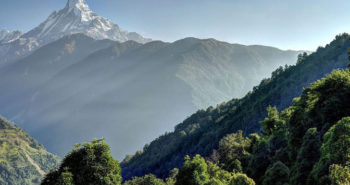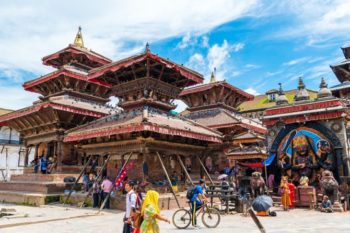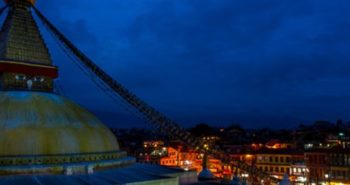Everest Base Camp Trek in August
Everest Base Camp Trek is popular for very good reasons. It takes trekkers to the base of the world’s highest mountain plus it tests their bodies and minds.
This strenuous trek focuses on the best Nepal has in terms of mountains, landscapes, people, and beauty. Starting off with a thrilling flight into one of the highest airports in the world, this trek takes you into the land of the Sherpas – those incredibly strong people well adapted to the high altitude and rough terrain of the region.
We, on the other hand, need to prepare ourselves before tackling such altitudes and rocky trails. In order to see the beauty of the world’s highest mountains, the glaciers, glacier-fed rivers and incredible exquisite sunrises and sunsets, it is important to ready our bodies by increasing our fitness.
Once you have worked on your fitness level, preferably by hiking in the hills in your own location, and purchased or hired all the gear you need for this long, almost 2-week trek, focus your mind on the adventure ahead.
It won’t always be easy, but it will always be stunning and something to remember forever.
Overview of Trekking to EBC in August
August is still monsoon season and the things to be aware of are slippery rocks and muddy trails. Rain may obscure the mountains behind a curtain of clouds and flights may be delayed. The weather will be warm and humid during the day, and you should be prepared for rain. However, it does not rain all day every day in the monsoon. Even less so at altitude. If it does rain, embrace it if it is light (assuming you have the correct waterproofs with you) or spend some more time relaxing or journaling in your lodge if it is heavy. Once the rain stops and the sun comes out, it will be glorious.
You should be aware there may be landslides on the route and pay attention to what your guide, and/ or other trekkers say about the trail ahead. If travelling solo, take advice from the lodge owners.
There will be fewer trekkers on the trails and plenty of accommodation to be had. And there is always good food to be had in the evenings.
Weather and Climate in August in the Everest Region
At Namche, the temperature will be around 16°C (60°F). As there may be some rain, you should be prepared mentally and with the correct gear. Mountains may be obscured by clouds but that only adds to the mystery!
Pros and Cons of Trekking to EBC in August
In the monsoon months, the biggest drawbacks are flight delays, some rain, and slippery trails. If you are from the northern hemisphere you should be no stranger to rain so get a pair of boots with good soles, a good rain jacket, and let’s go! But we should also mention leeches. Bring some salt to tackle those nasty things.
There will be fewer other trekkers, which is a plus if you like peace and quiet.
Preparing for the Everest Base Camp Trek
We encourage everyone who is coming to trek in the Everest Region to prepare their body and gear. But also, do not forget to prepare mentally. It’s a different culture and a different experience.
Physical Fitness and Training
If you are thinking of trekking in the Himalayas and particularly in the Everest Region, it is assumed you have a good general level of fitness. Don’t you? But even so, please increase your fitness regime before you come – especially hiking up and down hills if possible.
Acclimatization and Altitude Sickness
Unless you already live at an altitude (that is over 3,000m) you will need to acclimatize when you arrive in the Everest Region. The EBC Trek takes that into account and there are two acclimatization days built into the itinerary. These days are there for a purpose, so should not be left out even if you are travelling solo. Or perhaps we should say, do not leave them out especially if you are travelling solo.
Altitude sickness is always a risk, and you should do your best to reduce the risk by staying hydrated, taking those acclimatization days, and not travelling too fast. The first sign of a problem is a headache. Pay attention to that to understand if it is a regular headache (which will go away after some hours) or something more serious. If you feel dizzy or sick and are unable to sleep or eat you may be suffering from altitude-related problems. Tell your guide, companions, or lodge owner. If your case is mild, simply going back down to a lower lodge will do the trick. If after two days at a lower altitude, you still feel unwell, go down even further.
If you are unsure, there are some health posts on the trails that will advise you whether, in their opinion, you can go on or if you should go down or give up your trek for the moment.
Tips to Avoid Altitude-Related Illness
Stay well hydrated by drinking a lot of water. Do not be tempted to drink a lot of alcohol which will dehydrate you.
Keep your energy up by eating dinner and breakfast. Lunch on the trail should be eaten too if possible, otherwise, muesli bars and the like are also fine for lunch.
Take your time on the trek. Do not go faster than itineraries for the EBC Trek suggest. You need those acclimatization days.
If you have a headache, realise it may be something more serious than normal so keep a check on how you feel. If it is combined with being unable to sleep, feeling sick etc, consider going down to a lower altitude. Never go up further if you feel unwell.
Realise that altitude-related illnesses and problems can affect anyone no matter how young or fit they are. It is nothing to be ashamed of at all.
Obtaining Permits and Documentation
You need two main permits to trek in the Everest Region:
Khumbu Pasang Lhamu Rural Municipality Entrance Permit: Nrs 2,000 per person.
Obtainable in Lukla or Monjo. Not available in Kathmandu.
Sagarmatha National Park Entry Permit: Nrs 3,000 per person
The parking permit is obtainable at the Nepal Tourism Board Office in Kathmandu or in Monjo at the entrance gate for Sagarmatha National Park. It is more convenient at Monjo.
Gaurishankar Conservation Area Permit is required if you are trekking in from Jiri at Nrs3,000 per person. This is obtainable at the Nepal Tourism Board in Kathmandu.
Required documents for trekking permits: you need a copy of your passport for all permits. For the Gaurishankar Conservation Area Permit, you will also need to provide two passport-sized photographs. Pay in local currency.
Itineraries and Routes
Popular Route Options in August
All routes are open in August although try to find out if there are any landslides, potential landslides, or very muddy areas on the upcoming part of the trail.
Trekking with Helicopter Tour in August
Why not try our new 5, 6, 7, 8, or 9-day treks to EBC and return to Kathmandu by helicopter? This is a great way to experience trekking, a helicopter flight and a great way to save energy!
This is perfect for the monsoon when there may be more strenuous days due to rain and the after-effects of rain i.e. mud and landslides.
Modifications Due to Weather Conditions
There may be flight delays due to the monsoon weather so build that into your itinerary. There may also be a day or two when you don’t want to trek due to heavy rain. Although you should not worry too much about this at higher altitudes.
Trails will be open unless there are landslides – which your lodge owner may be able to alert you to.
Overall, the trek is still doable in August, you just need to realise there may be delays and plan accordingly.
Major Stops and Highlights Along the Way
Regardless of the month, the EBC Trek is famous for its great views and exciting places to explore:-
Flying into Lukla – the Hillary Tenzing airport – one of the highest airports in the world always provides a heart-stopping experience.
Trekking to Namche Bazaar via Phakding and into the Sagarmatha National Park. Crossing a few suspension bridges on the way, is an experience in itself.
Spending two nights at Namche Bazaar for acclimatization gives time to explore the market town and surrounding villages.
Visit the Tenzing Norgay Sherpa Heritage Centre situated at the Sagarmatha National Park Visitors Centre, Namche Bazaar.
Visit the Irish Pub in Namche for some Guinness, a game of pool and some entertaining music.
Several bars in Namche show films about Everest in the afternoon – look them up.
Find the best bakery in town for cakes and other goodies.
Visit the Saturday market in Namche Bazaar for local handicrafts and to see the locals buying their weekly shopping.
Hike to Khumjung. Here there is a school and health post-Edmund Hillary helped establish.
Go bird watching. Trying to spot Nepal’s national bird, the Danphe, might be an interesting way to spend the early morning.
Hike to Hotel Everest View. Great views of Everest are to be had while sipping hot coffee or tea on the terrace.
Stop in at Tengboche Monastery to meet Buddhist monks. Evening and morning pujas (religious ceremonies) take place daily and guests are welcome. Don’t forget to gaze at the wonderful mountain views from the monastery grounds. Note, it is usual to make a small donation to the Monastery.
Lobuche is a small, simple, but extremely important settlement at 4,940m/ 16,210 ft. Important as this is the last stop before Everest Base Camp.
Kalapattar is also known as Everest View Point. You can guess why! Climbing to the top at 5,500m may be hard but the views make up for the breathless climb.
Everest Base Camp. This is what it is all about!
Major Highlight of the Month
There are no major festivals in the month of August in this region and the trails are quieter with very few trekkers. This is therefore a good month if you like to be alone in the wilderness.
At lower altitudes, the forests and vegetation are green from the rains and the rivers are running fast. The mountains may be covered by clouds most days but that just gives you extremely interesting photographs and a sense of awe when the mountains do appear.
Other Highlights of Trekking to EBC in August Include:
• Sunset or sunrise from the top of Kalapattar. Wonderful regardless of the season.
• Exploring the Norgay Sherpa Heritage Centre in Namche. Opening on 29 May 2023, exactly 70 years after his and his partner’s success, this is now on the list of things to do in Namche so be one of the first to discover what is inside.
• Explore Khumjung village to learn more about Hillary and the Sherpas.
• Meeting other like-minded trekkers in the rain!
• Prices for accommodation will still be lower than in the main seasons.
• Mount Everest and the other mountains are always highlights of this trek.
Accommodation and Logistics for Everest Base Camp Trek in August
Teahouses and Lodges During the Trek in August
The well-established teahouses, as the lodges are known here, offer good accommodation at reasonable rates. There are a few more luxurious ones at lower altitudes which offer things like spa treatments. But on the whole, the accommodation is simple, with shared bathrooms and hot water for showers only if you pay for it.
Hot water will cost around $3 a time, and electricity to recharge your devices will cost you around the same time.
Menus prices are reasonable considering everything has to be brought in by plane and yak/ porter. Eat in the teahouse you sleep in. In the daytime, eat on the trail.
Food and Water Availability in August
Breakfast and dinner are taken in the lodge you overnighted in. Breakfast normally consists of fare of eggs, toast, porridge, tea, coffee, pancakes and Tibetan bread. Dinner is usually a choice of Sherpa food or Nepali, Indian, and Continental. The menus in the likes of Lukla and Namche will have more choices than those in the higher and more remote spots.
Drinking water is boiled water, for which you pay a small amount for. You could bring your own purifying system/ tablets. Watch where you collect the water from. You don’t want to get sick.
Beer and soft drinks are available. We suggest you do not drink alcohol until your last couple of days, if at all. It will lead to dehydration and possible hangovers.
Hiring a Guide and Porter in August
Porters and guides may be available for hire when you arrive at Lukla. Booking through a reputable agency guarantees to a guide and/or porter and saves you time and bargaining. It is always safer to trek with a guide or porter, and this is especially true in both the winter snows and monsoon mud and landslides when trails may change the route without warning.
Safety and Travel Tips for Everest Base Camp Trek in August
Monitoring Weather Conditions
Although it is monsoon, it doesn’t rain every day. But prepared for the times it does rain.
Finding out about the weather in the region is quite difficult and things change very quickly.
If you are interested in following what is happening on Everest weather-wise, you can do so through National Geographic’s own weather centre – the Everest Weather Station Network. For the weather where you are, you can put the setting for this station at its lowest (4,000m) to give you an idea of what is like at base camp and lower altitudes. https://everest-pwa.nationalgeographic.org/
Coping with the Weather and Altitude
Above you will find our tips for coping with altitude – which highlight acclimatizing and looking out for headaches and signs which could be altitude-related illnesses.
Waterproof boots and a rain jacket are the essentials for this month. Waterproof coverings for day packs and electronics are also highly recommended.
Travel Insurance and Emergency Services
Make sure your insurance covers you for trekking up to 5,000m. Emergency evacuation by helicopter: they will ask for proof of your insurance coverage before coming out.
If you require medical attention when you get back to Kathmandu, CIWEC Hospital in Lazimpat has decades of experience dealing with trekkers who suffer from stomach problems or altitude-related problems. They accept insurance.
The health posts on the trials will not accept insurance – cash only. Cards are also not accepted.
Health Posts Along the Trail
Your own first aid kit should be enough for simple cuts, bruises, and ailments. Your agency-booked guide will also carry one.
For more serious ailments there are some health posts on the trails to advice you if you should turn back or can continue on your trek. Listen to what they say.
Himalayan Sherpa Hospital, at Phakding, opened in November 2022 offering outpatient and emergency services to locals in its 15 beds. More information can be found here
Himalayan Rescue Association (HRA), is at Pheriche and is manned during the busy spring and autumn trekking seasons by volunteer doctors. It has been in operation since 1973, as a non-profit organisation with the objective of reducing casualties in the mountains. They give a talk on altitude-related problems every day at 3 pm which you are welcome to attend. As a non-profit, any donation you would like to give is also highly appreciated. More information is found here https://www.himalayanrescue.org/
The Mountain Medical Institute (MMI) clinic is found at Namche and Dingboche. Please note the Dingboche branch is closed in the winter months but will be open in peak trekking months. We are unsure about during the monsoon so call ahead. Staffed by doctors trained in the unique needs of people living and travelling at high altitudes, the clinic in Namche has a basic lab, EKG, and ultrasonography. Call: 985-2850021/ 981-3933179 / 984-1936205.
Be Responsible
Be responsible and prepared for everything you can be! However, accidents do happen, and locals will try to help you by making calls etc. Do not expect them to make financial contributions. Life is hard in the mountains.
Embracing the Challenges of Trekking in August
Embrace the rain! Hopefully not too much of it. There will however be clouds, slippery rocks, and mud on the trails. Flight delays are normal at this time of year.
Tips for Trekking in August
• With fewer trekkers the mountains feel like they belong to you.
• Mountains will be a little cloudy at times but very very atmospheric!
• Plan well for your trip as it can make or break your trek.
• Think hard about taking a guide and/or porter. They will make your trek more interesting, safer, and lighter. And you will be giving back to their families and community.
• Be careful when walking over slippery rocks.
• Do book your international flight some days after you propose to get back to Kathmandu. Delays can and do happen. Don’t get stressed – plan ahead!


